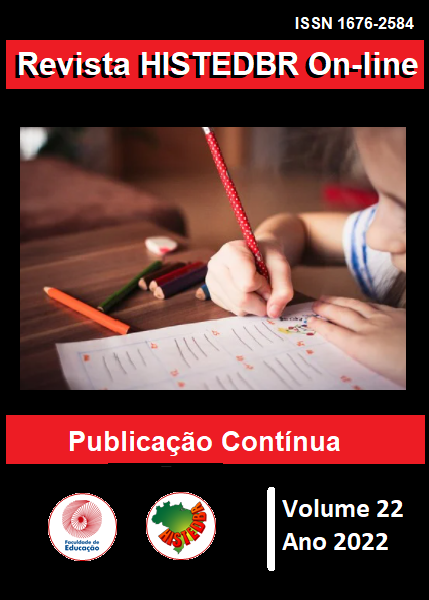Abstract
Since the 1930s, the government worried about schooling of rural population, then the majority. Rural education, however, didn’t fulfill expectations; it was founded on the curriculum aimed at urban school and unable to contain countryside–city exodus in the 1950s. As the countryside wasn’t emptied demographically, new generations has demanded education aimed at their needs. As another demand of social movements’, the educação do campo movement (education for the countryside) became a public policy to institute a model of education aimed at rural population. This work has addressed these questions in studying a private rural school in its transition to be public. It relies upon interviews with the teacher-administrator of the “Escolinha rural” (rural little school) in Candeal district, municipality of Cônego Marinho, MG. The starting point was the following question: what kind of school did she set up and how did she conduct schooling? The aim was to dialogue with rural life memories of what could be called as informal community-private school culture. The research used oral history as a guiding method to produce sources; besides, it’s drawn on document sources. Results analysis indicates “Escolinha rural” has little to do with the rural school substituted by the educação do campo movement. Its existence did not depend on the state. Still, just as rural education imposed on the rural school a curriculum foreign to the demands of its audience, the “little rural school” was subsumed by a model of escola do campo whose curriculum was strange to it.
References
ALMEIDA, M. Z. C. M. Educação e memória: velhos mestres de Minas Gerais (1924–1944). 2009. Tese (Doutorado em História) — Universidade de Brasília, Brasília, 2009.
ALTHUSSER, L. Aparelhos ideológicos do Estado: nota sobre aparelhos ideológicos do Estado. Rio de Janeiro: Graal, 1985.
BELTRÃO, J. F.; LOPES, R. C. S. Alteridade e consciência histórica: a história indígena em seus próprios termos. In: BELTRÃO, J. F.; LACERDA, P. M. (org.). Amazônias em tempos contemporâneos: entre diversidades e adversidades. Rio de Janeiro: Mórula, 2017.
BRASIL. [Constituição (1934)]. Constituição da República dos Estados Unidos do Brasil. 1934. Disponível em: https://bityli.com/OzR2w. Acesso em: 28 ago. 2016.
BRASIL. [Constituição (1988)]. Constituição da República Federativa do Brasil. Promulgada em 5 de outubro de 1988. Disponível em: https://bityli.com/bTtAt. Acesso em: 2 maio 2021.
BRASIL. Diretrizes operacionais para a educação básica nas escolas do campo — Parecer CNE/CEB 36/2001. Brasília: MEC, 2001.
BRASIL. Lei de Diretrizes e Bases da Educação Nacional, n. 9.394/1996. Disponível em: https://bityli.com/91Wfj. Acesso em: 28 maio 2021.
DALMAGRO, S. L. A escola no contexto das lutas do MST. In: VENDRAMINI, C. R.; MACHADO, I. F. (org.). Escola e movimento social: experiências em curso no campo brasileiro. São Paulo: Expressão Popular, 2011.
FARIA FILHO, L. M. de. et al. A cultura escolar como categoria de análise e como campo de investigação na história da educação brasileira. Educação e pesquisa, v. 30, p. 139-59, 2004.
GIL, M. [Entrevista concedida à] Ramiro Esdras Carneiro Batista. Comunidade de Candeal, Cônego Marinho, MG, jun. 2003. Entrevista gravada em áudio.
INSTITUTO BRASILEIRO DE GEOGRAFIA E ESTATÍSTICA. Censo Brasileiro de 2010. Rio de Janeiro: IBGE, 2012.
LEITE, S. C. Urbanização do processo escolar rural. 1996. Dissertação (Mestrado em Educação) — Universidade Federal de Uberlândia, Uberlândia, 1996. Disponível em: https://bityli.com/HHFOSudys. Acesso em: 13 set. 2020.
LIMA, R. G. O povo do Candeal: caminhos da louça de barro. São Paulo: Aeroplano, 2012.
MEIHY, J. C. S. B. Manual de história oral. 4. ed. São Paulo: Loyola, 2002.
MELO NETO, J. C. de. A educação pela pedra. São Paulo: Alfaguara, 2008.
OLIVEIRA, M. A. A. Os Laras no sertão dos guaybas: onde se fez morrer caboclo como o diabo. Belém: Folheando, 2020.
PORTELLI, A. História oral como arte da escuta. São Paulo: Letra e Voz, 2016.
RIBEIRO, B. O. L.; SILVA, L. A. A.; QUILLICI NETO, A. Educação rural em Minas Gerais: gênese das escolas municipais de Ituiutaba (anos 1940). HISTEDBR On-line, Campinas, n. 46, p. 74-93, jun. 2012. Disponível em: https://bityli.com/ItaTfmbL. Acesso em: 8 maio 2022.
ROCHA, C. A.; MESQUITA, M. C. G. D. Educação no e do campo: dualidade de expressão e significado. In: ALMEIDA, M. Z. C. M.; BALDINO, J. M.; PEREIRA, A. M. F. (org.). Educação no/do campo: histórias, memórias, políticas públicas e práticas educativas. Goiânia: Espaço Acadêmico, 2020.
THOMPSON, P. A voz do passado. Tradução de Lólio Lourenço de Oliveira. 2. ed. São Paulo: Paz e Terra, 1998.

This work is licensed under a Creative Commons Attribution-NonCommercial 4.0 International License.
Copyright (c) 2022 Revista HISTEDBR On-line


